
Scratching furniture: Why do cats do it and how to stop it

Lucy Hoile
24 October 2023 | 8 minutes read
For many people, claw marks are an affectionate tell-tale sign of a feline-ruled household.
But if you’re struggling with inappropriate scratching, expert behaviourist Lucy Hoile is here to help.
Read on to find out why cats scratch and how to stop them from using your furniture as a playground for their claws.
- Why do cats scratch?
- Why do cats scratch furniture?
> How to stop cats from scratching furniture/the sofa
> How to stop cats from scratching at the door - Why do cats scratch carpets?
> How to stop cats from scratching the carpet - Why do cats scratch wallpaper?
> How to stop cats from scratching wallpaper - What cats need in a cat tree/scratch post
> How to encourage your cat to use their scratch posts
> Replacing a cat tree
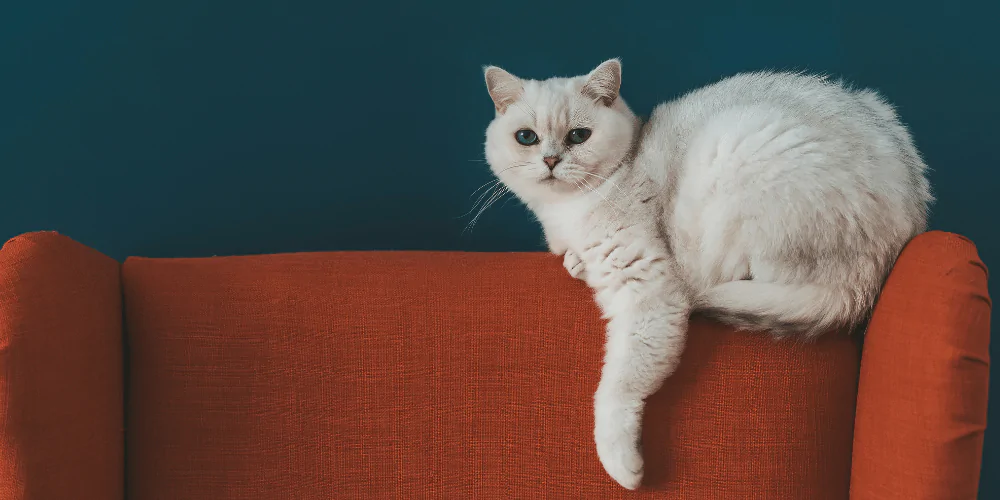
Why do cats scratch?
Scratching is a natural, ingrained behaviour for all felines and is used in several different ways.
Sharpening their claws
The main purpose of scratching is to help cats maintain their claws. Many cat parents think that scratching dulls down the claws, but it actually has the opposite effect. By scratching, your cat is removing the outer layer of the claw to reveal a sharper one underneath.
It’s essential for your cat to keep their claws nice and sharp because:
- As a predator, having sharp claws helps them to hunt more effectively.
- Being a prey animal, they also need a way to protect themselves if needed.
Marking their territory
Cats scratch as a subtle way of marking their territory. The scent glands in their pads are a much cleaner alternative to urine marking.
Felines may decide to use scratching to mark near back doors and windows as these are important access areas to their territory.
Stretching their muscles
Many of us love a good stretch – and cats are no exception! Some cats will wake up and have a big stretch at the top of their tree post. Scratching helps them to stretch properly and really make use of their muscles.
Attention seeking
Scratching can be a deliberate behaviour to get your attention and can be easily reinforced. It’s the fastest way for your feline to get your focus – and don’t they know it.
That’s why they’ll target that brand-new sofa or your favourite chair. They’ll scratch it and wait to see your reaction. Even getting told off is enough of an incentive for them as it’s still a form of attention.
Showing their frustration
A closed door can frustrate cats as it cuts off part of their territory, especially if they can hear family members on the other side. So they’ll superficially scratch at the door to get you to open up.
Opening the door then reinforces to your cat that this behaviour works for getting them access to blocked-off areas.
Cats may also scratch more if they’re stressed. Speak to a behaviourist who can help you to reduce your feline’s stress levels.
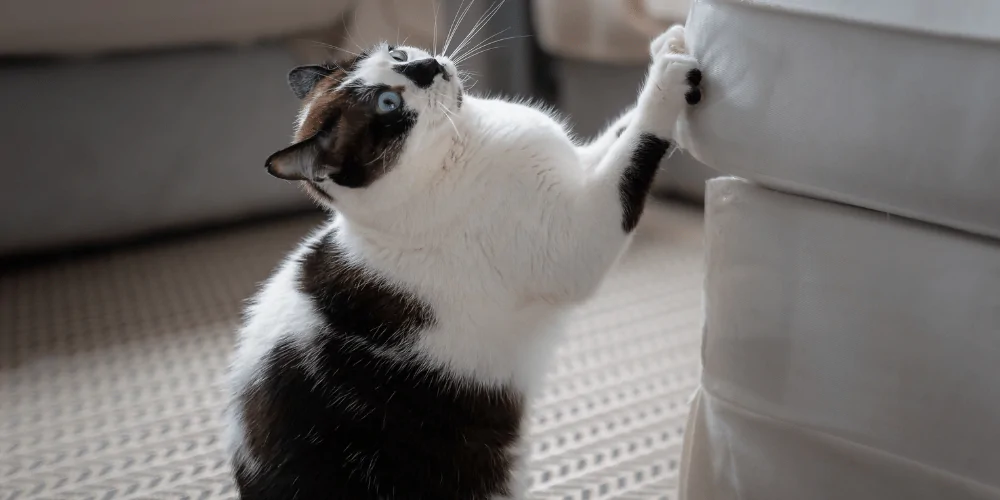
Why do cats scratch furniture?
Felines may be drawn to sofas and beds because they:
- Offer a vertical post for scratching
- Are sturdy
- Are quite high up, which allows for better stretching
- Are usually made from a material that makes it easy to get claws in
- Normally sit in a prominent place in the house where everyone spends time
- Are convenient to reach
- Will get your attention if it’s a favourite armchair
> How to stop cats from scratching furniture/the sofa
There’s a few options to deter your cat from your furniture:
- Cat cardboard scratcher – should be big enough for your cat to sit on it properly and weigh it down while scratching
- Carpet square – should have a really thick loophole weave and you’ll need to give your cat plenty of praise for using it.
> How to stop cats from scratching at the door
The worst thing to do with door scratching is to ignore your cat for long periods and then just give in and open up. This is just training them to scratch for longer.
Try leaving doors open to rooms you use, so that your cat has freedom of social areas in the house.
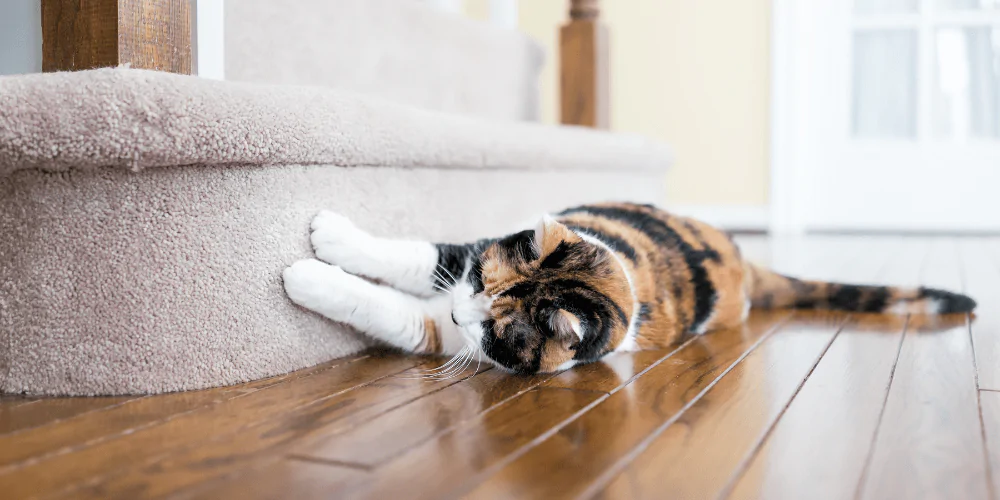
Why do cats scratch carpets?
There’s several reasons a cat may be sinking their claws into your carpet:
- Many cats prefer to scratch on flat surfaces and so may bypass a cat tree in favour of a carpet. Some felines may also enjoy a thick rug.
- Stairs are a common target for those itching claws as they give felines both horizontal and vertical scratching options.
- Carpets are often laid in prominent areas of your cat’s territory so your cat may scratch to mark these areas.
Your carpet pile usually needs to be thick and help with claw maintenance to be enticing for your cat.
> How to stop cats from scratching the carpet
Digging enough at the carpet can make parts of the fabric come loose, which gives your cat something fun to play with. So appropriate alternatives should always be available. This will stop the behaviour before it becomes a habit.
Try placing cardboard cat scratchers on areas of the carpet your cat favours and see how they get on.
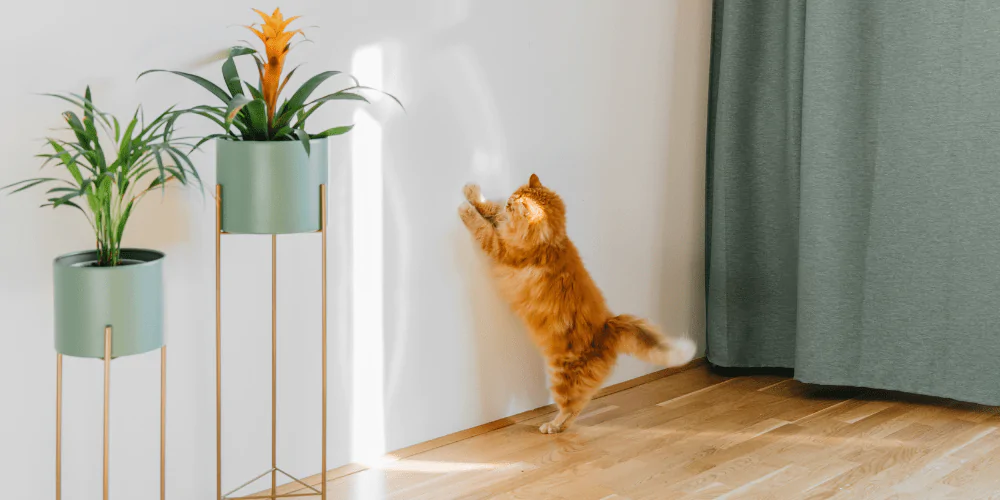
Why do cats scratch wallpaper?
Wallpapers made from a thick textured material can be tempting for cats to use as claw maintenance or to dig at for attention.
And once they’ve worked at it enough to create dangling strips, the paper becomes a fun object to play with.
> How to stop cats from scratching wallpaper
Try encouraging your cat to use a tree or cardboard scratcher. If this doesn’t work, you may need to change your wallpaper to something less textured or paint the wall instead.
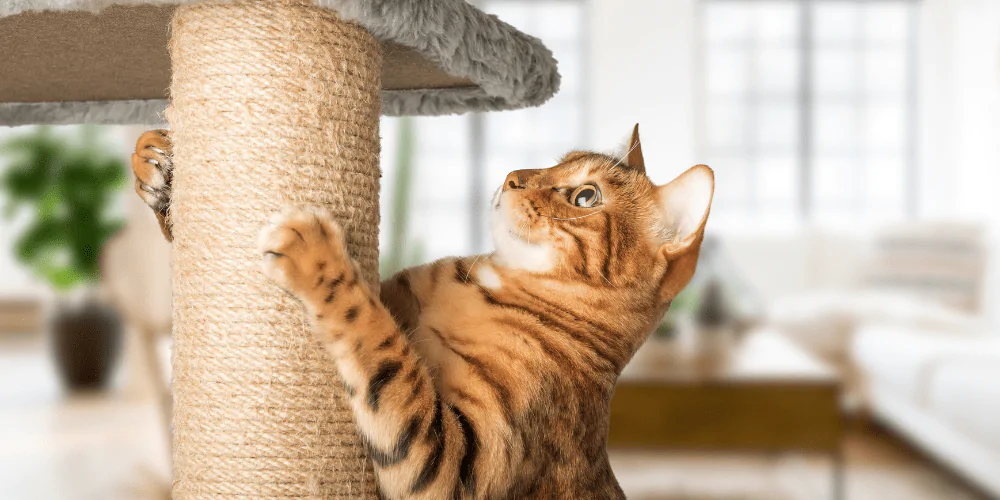
What cats need in a cat tree/scratch post
Every cat needs a cat tree in their house to help them feel safe and confident.
It’s a vital part of their territory that’s heavily scented from scratching and sleeping. It also gives your cat a high space to escape and observe their surroundings if they’re feeling nervous.
The cat tree should:
- Have multiple levels and platforms for different cats to use in a multi-cat household
- Be placed in sociable areas so they’re part of family activities but also have their own space
- Have a central post that’s tall enough for your cat to stretch to their full height
- Be solid and sturdy, so it doesn’t fall over when your cat tries to climb on or do claw maintenance
It’s fine for your cats to share a cat tree but ideally, there should be at least one tree per cat, plus an extra one. This makes sure there’s plenty of opportunity for scratching among all your felines.
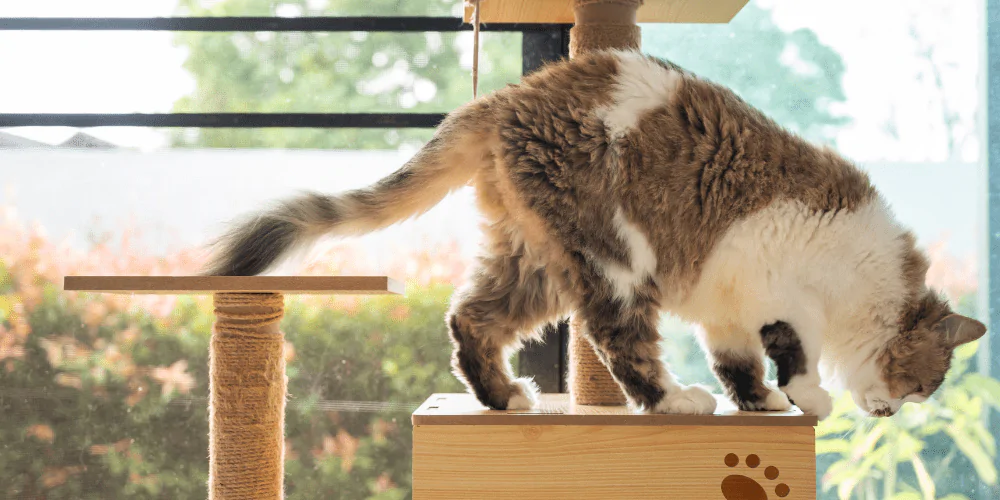
> How to encourage your cat to use their scratch posts
Find the right material
- Take the time to learn what your cat likes to scratch. You can then pick a material that really suits their scratching needs.
- Many cat trees are made from sisal ropes but some cats need a looser fabric. Examples include hessian, carpet, and cardboard.
Give them a mixture of scratching angles
- If your cat has a great scratching post but is clawing at the arm of your sofa, they may need more angle variety.
- Some cats like to scratch vertically, some horizontally, and others like a mix of both. So give them plenty of choice.
Choose the right location
- Place the post somewhere convenient for your cat to reach and where they spend most of their time.
- It’s also useful to put a post where they sleep as they may want to stretch and scratch when they wake.
- Think about their territory set-up and put posts in areas where they may feel vulnerable. For example, by doors, windows, and cat flaps.
- Make sure your cat has scratching areas in the garden if they go outdoors. This could be tree trunks, logs, or fence posts.
Make it fun and rewarding
- Trail toys along the top of a cat tree to encourage your cat to run on it.
- Look for towers with accessories like hanging rope balls which are especially enticing for kittens.
- You can reward your cat with praise, treats, or toys, but this may not be practical as it could startle them. So be gentle if using praise as a form of encouragement.
- You can also sprinkle catnip if your feline likes it – this is especially good for cardboard scratchers.
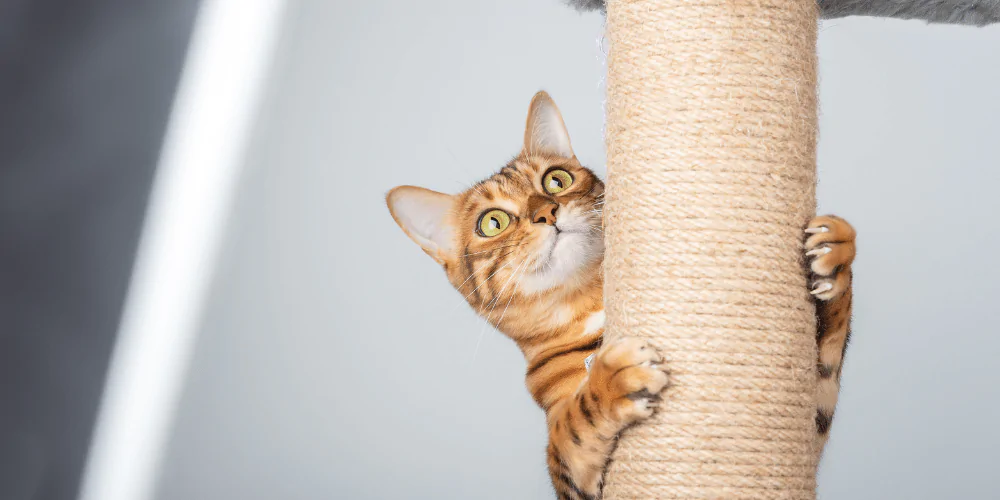
> Replacing a cat tree
A cat tree that has become rickety and dangerous needs replacing – but this should be done carefully:
- Your cat has marked the tree with their scent and made it their own. So swapping straight over to a new one with unworn posts can be very unsettling.
- Instead, keep the old tower in the house while you bring the new one in. Let the new tower become established in your cat’s territory for a few weeks, then remove the old one.
- If you have a sisal rope cat tree and it’s just the rope that’s looking a bit worn, no need for a full replacement. You can simply unpick the existing rope and buy some new rope to wrap around the post.
Try and watch out for earlier signs that your cat’s tower needs replacing. This will give you enough time to settle in and safely transition your cat to a new tower before the old one becomes a risk.
Protect your favourite clawed friend throughout life’s adventures with flexible cat insurance from Petsure.


